text: william varley
frozen by distance
october 1990
Frozen by Distance, the title of one of Christopher Jones's paintings, seemed such a poetic metaphor that I wanted to know its origin. 'Was it an allusion to a sense of cultural displacement that you might have experienced?', I asked him, knowing, as I did, that he had felt a certain alienation during his stay in Japan, where the picture was painted. He smiled tolerantly: 'No, it was actually based upon experience. One day when I was working on that painting which is a square within a square so that the central image is, as it were, framed by a border in counterpoint to it, I looked through the studio window which was also a square and saw a bird sitting so calmly in the landscape that it might have been frozen. The window framed by the studio wall gave on to a space which was as much psychological as geographical. I saw my painting that way, too...'
|
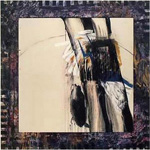 |
|
That story perfectly exemplifies Jones's most enjoyable, and most productive, moments when painting. The chance occurence, the random perception, the happy juxtaposition of disparate images, the Midas magic of converting that base scrap into an eloquently resonant passage of colour, is his central stratagem. This 'contemplative', but also vigilant, mode of painting is accompanied by the methods of an archaeologist: image retrieval is achieved by 'loading a painting and then scraping it away'. In truth he has been using these methods for some time, since the early 'eighties', in fact, when his small-scale collages, generated by the memory of Moorish architecture in Spain, presented the spectator with evanescent fragments - an arch half seen in shadow, for instance - or survivals from his earlier abstracts. Sometimes surreal fragments of imagery from the baroque imagination of Busby Berkeley were incorporated in a synthesis which established a dream-like mood or an ambivalent world of continually shifting meanings. |
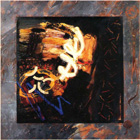 |
|
The Busby Berkeley imagery recurred in the larger canvases of 1987. Berkeley Jig 1, however, has more in common with the mechanomorphic fantasies of Duchamp's Large Glass than with the camp routines of the Hollywood chorepgrapher. Like its companion paintings of the same time, it was composed around a diagonal axis, an inserted panel which enabled the possibility of change. It was painted in three zones and mixes different ways of painting (an elegant blotch borrowed from Motherwell, for instance), the use of templates and stencils as well as free gestures, differing conventions of spatial representation (plunging perspectives and 'floating' passages of colour) as well as a variety of speeds of imagery: some images are static whilst others skid across the surface of the canvas. The images themselves included favourite devices - a tuba, a microphone, the thorns from a rose bush - which were to become leitmotifs of Jones's work. In the top right-hand corner, however, is a flat suggestion of a surburban rococo light fitting - a distant memory of Brief Encounter (though in truth, if Jones's paintings had to be likened to films they would most appropriately be compared to Tarkovsky's with their shifts, displacements and eliptical connections). Those shifts, often as pronounced as geological faults, reappear in Berkeley Jig II wherein the central diagonal panel seems to have slipped to the right and reconstituted itself, as a painted smear. Not surprisingly, with its garland of roses, harsh introduction of thorns and a decorated, tasselled scarf that weaves back and forth across the picture plane like a fragment of sacred regalia, some commentators have remarked on its religious content. |
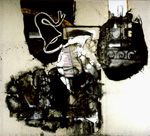 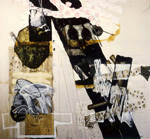 |
|
In the series of large-scale works on paper which succeeded this group, the elements and devices marooned in the infinity of a white ground, were replaced by richly textured, packed atmospheres. Jones produced them by developing several paintings simultaneously and would borrow and recycle templates and images so that the sibling of a saxaphone would surface, in negative, from one painting to another. In these improvisations on themes of materialisation and dematerialisation a human presence, albeit conjured according to the playful mechnaics of Duchamp and Picabia, is never far away. While producing these paintings, Jones had made his first visit to Japan and in 1987 embarked on a longer stay, a two-year scholarship at Kyoto University of Arts. Temperamentally attuned to the country, he was also keenly aware of his foreignness but, like European film-makers such as Wim Wenders who see the American scene with a keener eye than their counterparts amongst the natives, he was very quick to assimilate experiences of every kind, both visual and non- visual. In the series of works which he produced, each painting consisted of a square within a square with the ensuing border being crucial to the overall structure. Crossing the Wire - Catching the Thread (the painting which really does hint at his sense of alienation in a foreign land) is, however, the exception which proves the rule. Here an extra rectangle has been added to the base of the painting while the inner square has been reduced and left unpainted. An innocently literal reading of the consequent image might be of a film screen (films again), from which the projected events have somehow slipped and are flickering on and off in the space of a room. A less literal interpretation still yields a disturbingly ambiguous construction in which the dull crimson border sometimes towers over us and sometimes recedes. The 'cubist' still-life of bottle, telephone and box, placed within a shadow of which Braque would have wholly approved, compounds the sense of unease occupying, as it does, a palpable space whilst being surrounded by spatial compression. |
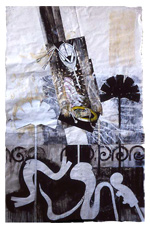 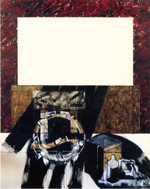 |
|
In this series it is very much as if the pragmatist collage methods of his earlier work had yielded to more spontaneous painting. The organic development of paintings remained however: areas of paint would be established and then wiped out, or obliterated, areas of lacquer or varnishes would be introduced (Japanese art was, after all, around him everywhere), and his favourite compositional devices - the plunging diagonals and fluttering ribbons - remained. Mysteriously, some of the harsher images persisted too, the thorns, for instance or the carapaces that make one think of the cruelties of Bosch. Often though, these paintings look as if they came into being by some process akin to parthenogenesis or that at any rate the artist had adopted the role of the distant master of ceremonies. Or perhaps not. Like Tarkovsky's Stalker, Jones lies in wait, watches, ensnares, reveals - or merely hints. It is the strategy of the poet. |
||